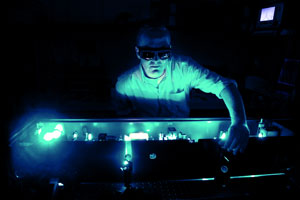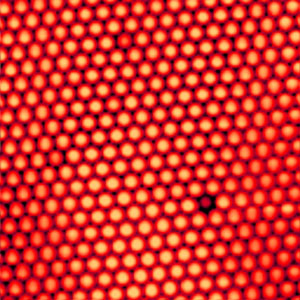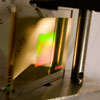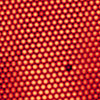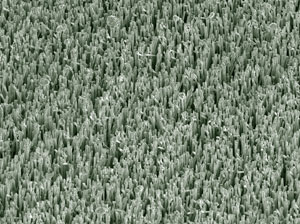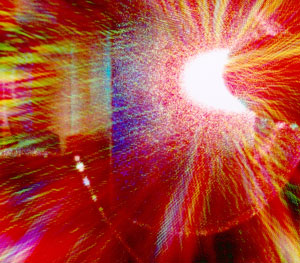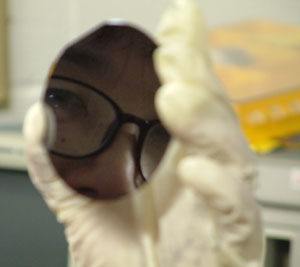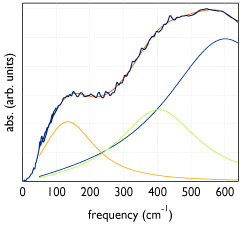The Flash animation below explains the process by which terahertz radiation is generated. A 100-femtosecond laser pulse strikes the nanostructure under a specific angle allowing it to couple with surface plasmons. Surface plasmons in the gold layer concentrate the fields causing electrons to be pushed out in ultrafast (femtosecond) bursts. These ultrafast electric currents then emit terahertz radiation.
Notes
Terahertz radiation (or millimetre waves, with a frequency of 1012 Hz) consists of light waves with a wavelength in between microwaves and normal infrared radiation. Terahertz radiation can be used for imaging of concealed objects such as weapons, medical imaging, and the detection of certain chemicals such as explosives and drugs. All objects at room temperature emit a continuous stream of terahertz radiation. We are particularly interested in terahertz pulses with a duration around a picosecond (10-12 s). Such ultrashort pulses are important for fundamental studies of novel materials, the study of biological processes, and particle accelerators. The generation and application of terahertz pulses has been studied intensely for the past 10 years or so with now about 500 publications a year. The Strathclyde group led by Klaas Wynne has been working in this area since 1996.
Our new contribution (published in Physical Review Letters) is that we have discovered an entirely new process by which picosecond terahertz pulses are produced using a nano-engineered material. A nanostructured surface – consisting of a shallow glass grating with a 50-nanometre thick layer of gold – was designed to couple visible femtosecond (10-15 s) laser pulses to plasmons on the surface of the gold. (Wiki on surface plasmon resonance) Surface plasmons are nanometre scale waves in the sea of electrons in a metal. The nanostructures have the property that they can concentrate laser and plasmon fields to enormous strengths leading to extreme nonlinear phenomena. In our case, the concentrated fields push electrons out of the metal and out of the entire nanostructure. This gives rise to a femtosecond burst of electricity rushing out of the structure. The burst of electricity emits radiation at terahertz frequencies much like a modern ultrafast version of Heinrich Hertz’ 1886 experiment scaled down in size by a billion times. (Wiki on Hertz)
The experiment was a proof of principle experiment but already produced as much terahertz radiation as one of the best nonlinear optical crystals (ZnTe) and could be commercialised. The research group is now making nanostructured surfaces using self-assembly techniques in a quest to find even better terahertz emitters.
Further details
The paper is: Gregor H. Welsh, Neil T. Hunt, and Klaas Wynne, ‘Terahertz-Pulse Emission through Laser Excitation of Surface Plasmons in a Metal Grating’, Physical Review Letters 98, 026803 (2007). Local copy of PDF.
Also see: J. Zawadzka, D.A. Jaroszynski, J.J. Carey, K. Wynne, "Evanescent-wave acceleration of ultrashort electron pulses", Appl. Phys. Lett. 79, 2130-2132 (2001) [abstract] [doi:10.1063/1.1406562] [local copy of PDF]
The work was supported by grants from EPSRC and the Leverhulme Trust. The work was performed in the Wolfson Nanometrology Laboratory, which is part of the Biomolecular & Chemical Physics group at Strathclyde (BCP, http://bcp.phys.strath.ac.uk/), and in the Strathclyde Electron and Terahertz to Optical Pulse Source (TOPS, http://tops.phys.strath.ac.uk/).
Press
11 May 2007: Our work on terahertz emission from gold coated gratings was picked up by optics.org and was published in Optics & Laser Europe.
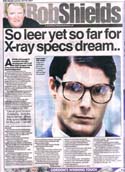 24 April 2007: Oh no, we're in the Daily Record as well: a very short story yesterday and in a column by Bob Shields (his html column is here and a scan of the newspaper article is here). Quite fun to be referred to as a boffin... now if we actually worked on X-ray specs we could send a pair to Bob.
24 April 2007: Oh no, we're in the Daily Record as well: a very short story yesterday and in a column by Bob Shields (his html column is here and a scan of the newspaper article is here). Quite fun to be referred to as a boffin... now if we actually worked on X-ray specs we could send a pair to Bob.
23 April 2007: A press-release came out on the Strathclyde website on our terahertz work using nanostructured surfaces. The press release was also taken up by the Technology Scotland website. The Interference Technology website picked it up under the title Terahertz Pulse Research Could Boost Homeland Security and Medical Imaging. Finally, it also appeared on the Scottish Enterprise website as Boost for medical imaging
 22 April 2007: Our terahertz work was "featured" in the Sunday Times (300kB, jpg) of 22 April. Unfortunately, it seems they think we work on T-ray (or even X-ray) specs... How they got human rights linked to it, who the hell knows?
22 April 2007: Our terahertz work was "featured" in the Sunday Times (300kB, jpg) of 22 April. Unfortunately, it seems they think we work on T-ray (or even X-ray) specs... How they got human rights linked to it, who the hell knows?











